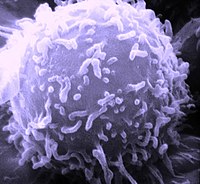
Photo from wikipedia
Introduction T cell receptor beta (TCRβ) immune repertoire analysis by next-generation sequencing is a valuable tool for research studies of the tumour microenvironment and potential immune responses to cancer immunotherapy.… Click to show full abstract
Introduction T cell receptor beta (TCRβ) immune repertoire analysis by next-generation sequencing is a valuable tool for research studies of the tumour microenvironment and potential immune responses to cancer immunotherapy. Here we describe a TCRβ sequencing assay that leverages the low sample input requirements of AmpliSeq library preparation technology to extend the capability of targeted immune repertoire sequencing to include FFPE samples which can often be degraded and in short supply. Material and methods This assay targets the highly diverse CDR3 region which allows for T cell clone identification and frequency measurement which, when combined, can provide a broad view of the immune landscape within tissue samples. The assay allows for functionality with either RNA or DNA input, with little modification of the library construction workflow, as well as flexibility in sequencing throughput and sample multiplexing capability. Results and discussions To evaluate assay accuracy, we sequenced libraries including known amounts of 30 well-studied T cell lymphoma rearrangements, as well as evaluation of samples comprised of known numbers of sorted T cells to ensure the absence of false rearrangement reporting. T cell repertoires were evaluated from as low as 5 ng to as large as 1 ug of input from samples of varying repertoire diversity, such as sorted T cells, peripheral blood leukocytes, fresh-frozen tissue, and FFPE tissue from a variety of normal and cancerous tissues such as lung, colon, brain, spleen, lymph node, and thymus. In parallel, we have developed a low input qPCR assay, based on known T cell markers, which allows for a quantitative measure of the T cell content across all sample types applicable to the TCRβ sequencing assay. This sample quantification test acts to guide optimal sample input ranges for library construction and required sequencing depth. Finally, we present the CDR3 TCRβ sequencing assay including a dual barcoding approach to extend sensitivity for detection of rare clones. Conclusion These data present a T cell immune repertoire sequencing solution for application in a wide range of sample types, in particular, challenging FFPE samples. We find that the assay is capable of profiling repertoire metrics from FFPE samples over a large range of input amounts from several normal and tumour tissue types. In addition, we demonstrate use of a qPCR assay for quantification of sample T cell content to guide sample input for TCRβ immune repertoire sequencing experiments.
Journal Title: ESMO Open
Year Published: 2018
Link to full text (if available)
Share on Social Media: Sign Up to like & get
recommendations!